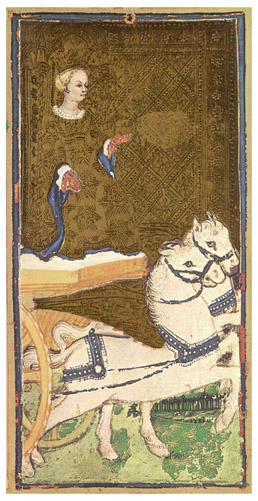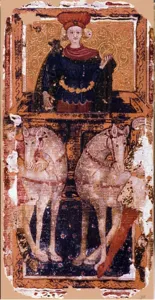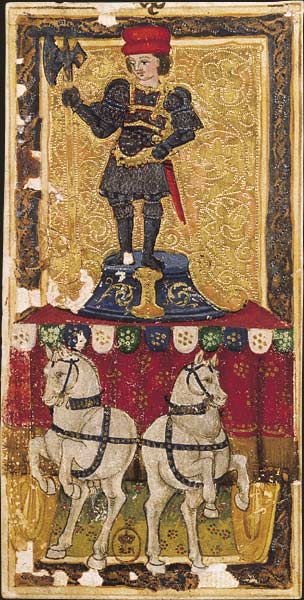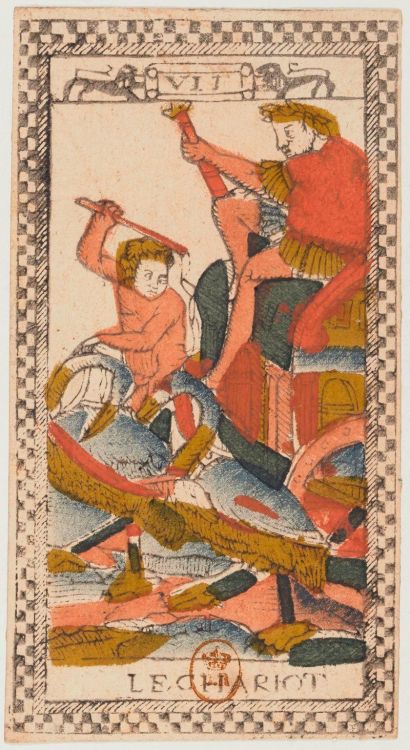

The Chariot card transports us through the ages, where the chariot, with its horses, driver, and archer, was the ultimate war machine.
For over 2000 years, from the Bronze Age to the Iron Age, chariots were coordinated units on battlefields. We are familiar with the famous battle of Ramses II against the Hittites in the 9th century BCE. However, Alexander the Great ended the era of war chariots when his mobile cavalry was defeated by Persian chariots.
In ancient Rome, chariots became statuary symbols, displayed by the elite during ceremonies. Triumphal processions were grand events. Victorious generals or emperors paraded through the streets, driving chariots pulled by horses. Lavishly decorated, these chariots symbolized power and victory. They were drawn by four white horses, surrounded by hundreds of soldiers. High-status captives were displayed on chariots, while others overflowed with plundered treasures. Publicly humiliating the defeated or enslaved served as a reminder of the duality of triumph and defeat.
Andrea Mantegna's work "Triumph of Caesar" illustrates this imagery. Crowned Caesar holds a laurel branch, a Roman symbol of victory. The chariot itself became a symbol of triumph and control, often adorned with celestial elements like stars, signifying divine approval.
During the Middle Ages, processions lost their military character. Sacred relics were exhibited in religious processions, protected by an umbrella held by four people. The use of these umbrellas directly recalls the one above the prince in the Chariot card.
Later, in the 15th century, triumphal processions reached their peak. Alfonso V of Aragon celebrated his entry into Naples in 1443 with a parade designed to impress with its wealth and splendor.
Petrarch's literary work "Triumphal Parade" directly influenced the future tarot trumps. In this poem, six allegorical figures triumph over each other, much like the numbered cards in the deck. Artists drew inspiration from these triumphs, reproducing them in tapestries, illustrated books, and murals. The alternative name for the Tarot trumps (also known as the "Major Arcana" or simply "the Arcana" in divinatory tarot): the "Triumphs," directly comes from Petrarch's work.
Artist P.C. Lino illustrated Petrarch's six allegories in a triumphal procession on the sides of a wedding chest in 1445.


The game of "Triomphi" draws inspiration from the triumphal parades of the 14th and 15th centuries. The earliest hand-painted chariot cards were commissioned by the rulers of Milan. The "Triomphi" card from the famous Visconti Sforza deck depicts Bianca Maria Visconti, daughter of the Duke of Milan, marrying the condottiere Francisco Sforza.
The Chariot follows the Lovers card and may evoke the allegory of chastity triumphing over love in Petrarch's literary procession. Some interpret this card as the triumph of chastity, but the woman holding a scepter and the Visconti heraldic symbols (dove and sunray) further demonstrate how Visconti dominates Milan. Ten years after their marriage, Bianca and Francisco Sforza commissioned another luxurious gold leaf tarot. The two winged horses symbolize fame.
The card of Alessandro Sforza, with a face-to-face chariot, depicts horses whose bodies turn toward each other. The chariot is partially covered, the driver holds a globe and a sword, and his red hat is typical of the era.
The Charles VI card, from the same workshop, features a red hat similar to Alessandro Sforza's card, but with an axe instead of a scepter. The axe naturally evokes the character's martial and conquering prowess.
In France, the front-facing chariot with a standing prince was not immediately adopted. For example, in the anonymous Paris Tarot, we see a chariot more suited for a leisurely stroll in a park, as it is drawn by animals.
In Catelin Geoffroy's Chariot card, a dejected old man holds a bouquet of flowers in place of the prince. He sits on a curved throne on a podium exposed to the crowd. The horses are red and white, and a valet struggles to control them.
In the Marseille Tarot, the Chariot is depicted head-on, with a standing prince visible up to the waist. He holds a scepter and a crown. The horses, however, do not necessarily seem to be moving in the same direction. This image of the chariot has remained virtually unchanged to this day.
It's worth noting that from the earliest versions of the Chariot in the Marseille tradition, the shield at the front bore the initials of the engraver or publisher.
The absence of reins, held by the character, has sparked numerous interpretations in the divinatory use of the tarot. Some say that the prince commands the horses through sheer will and mind. However, I have a different interpretation: the prince simply does not control his chariot. It is the horses themselves who direct it, going wherever they please, against the prince's will. In short, the character acts more according to desires and impulses than reason and wisdom.
One notable difference in the canonical form of the Marseille Tarot between Type I and Type II is the shape of the umbrella in the Chariot card. The umbrella above the prince is serrated for Type I, and it is taut and secured with knots for Type II. To this day, I do not have precise information explaining this change. Was it simply a decorative fashion that shifted between the 17th and 18th centuries? Or did this change hold a deeper, initiatory meaning for the master cardmakers, starting with Pierre Madenié?
Occultist Eliphas Lévi, in his work "Transcendental Magic" published in 1855, speaks of a chariot pulled by two sphinxes: one black and the other white. This vision was later adopted by Oswald Wirth, who created a Chariot almost identical to Lévi's description. Subsequently, Arthur Edward Waite drew inspiration from Wirth's representations to design his own Chariot card.
Unlike Wirth, Waite depicts the Chariot pulled by complete sphinxes. The driver, instead of a royal crown, wears a laurel wreath—a symbol of earthly honors—topped with a golden star. The chariot's wheels are massive and face forward, distinguishing it significantly from traditional versions of the Marseille Tarot. Behind the prince and his chariot, a fortified city appears on the horizon.
Waite retains some elements from Wirth, such as the winged globe and the Lingam on the chariot's shield. However, he does not explicitly mention them in his book. Perhaps he considers them design elements rather than significant symbols.
I must admit that this card doesn't particularly excite me. However, it allows me to address a rarely discussed topic: the representation of the Chariot by Arthur Edward Waite. In the Exotic Cancer Tarot, the chariot is driven by a woman and pulled by two masked men. This complete inversion compared to Waite's choice intrigues me.
In the traditional Marseille Tarot, horses pull the chariot. But in the Rider-Waite-Smith version, two sphinxes with feminine features take their place. The prince, in turn, subdues these two female figures to his will. Although this representation is rooted in historical context, it raises questions. In our modern era, where women's voices resonate louder than ever, this dominant masculine image seems out of place.
I find it surprising that this representation doesn't spark more debates among tarot enthusiasts, who are predominantly women. Especially when activist tarot decks, like the Exotic Cancer Tarot or others, celebrate feminine power. The Exotic Cancer Tarot flips the script by showing a woman dominating two men; it's a shift from one extreme to another.
Renaissance master cardmakers were ahead of their time and held feminist views. They considered men and women equal in rights but also complementary. The realization of man came through transcending with woman. This vision opposed the values of the Church, which had long demonized the female body and subjected women to male authority.
Thus, the most negative cards, like the Hanged Man or the Devil, feature male figures. Conversely, positive cards like Strength, Temperance, the Star, and the World celebrate femininity. Jean Noblet's Marseille Tarot, for instance, juxtaposes a man and a woman in the Sun card, evoking the integration of anima and animus according to Carl Jung's theory. In the Marseille Tarot, the Chariot still represents a world marked by dominant masculinity. But at the end of the Fool's journey, it's the World card—with a woman at the center of sacred elements—that offers illumination and ultimate realization.
What immediately captivates me in this image is the prominence of a feminine figure. Despite the name "The Archer," the elegance, face, and silhouette of the character lead me to believe it's a woman. Compared to the previous representation of The Chariot in the Cancer Exotic Tarot, this one feels more authentic.
The archer, drawing the bowstring and ready to release the arrow, is entirely focused on a goal. Just as they aim at their target, they offer a beautiful alternative to the traditional symbolism of the card. The Chariot's driver, the prince, is also single-minded in pursuit of a primary objective. However, the archer introduces a counterpoint: this extreme concentration can sometimes blind us. Our decisions may lack clarity and balance because we neglect the broader context.
In this representation, The Chariot symbolizes complete commitment to a specific purpose. But beware of excess! Too much focus can prevent us from seeing other essential elements. Finding the balance between determination and considering the context is key. Like the archer, we must aim accurately without losing sight of the entire landscape.
As always, the Sasuraibito Tarot presents an image that, while not abstract, remains relatively simple. This time, it depicts a horse in full fury. My opinion? This representation powerfully evokes The Chariot card, even though it can be interpreted from a negative angle.
The almost enraged, wild, and uncontrollable horse embodies the darker aspect of The Chariot. In a negative interpretation, this total commitment can turn into a frenzied race where we lose control of events. Like the horse, we risk becoming furious and violent—towards others and ourselves (imposing a true ordeal). We stubbornly follow a path that may satisfy our desires but doesn't fulfill our deeper needs. When we listen to ourselves less, ignoring our inner needs, we lose our balance. The Chariot, in its symbolism, reminds us that total commitment must be accompanied by attentive self-awareness. Otherwise, we may gallop toward a goal that won't bring true peace.
In this card, which seems to offer a rather dark representation of The Chariot, I discern several intriguing elements.
The Armor: The heavily armored aspect of the chariot evokes a character ready for battle, without necessarily being a warrior. The helmet, adorned with menacing teeth, appears poised to bite anyone who dares oppose it.
Horns and Chimneys: The helmet's horns, if I understand the creator's intention correctly, resemble chimneys. The smoke emanating from them could corroborate the tall chimneys in the background. This image reflects the idea of total commitment but also inner anger. The chariot's driver seethes, burning from within, attempting to maintain control despite tumultuous events. As if their soul is ablaze, they grit their teeth, seeking self-preservation amidst external turmoil.
Tricycle Wheel: Finally, the small wheel of the chariot, almost like that of a tricycle, catches my attention. Perhaps it wasn't the author's primary intention, but it aptly evokes the childish behavior of the driver. Refusing compromise, they lack the maturity expected of a responsible adult.
In summary, the Deviant Moon Tarot invites us to explore the duality between external strength and inner self.
The New Vision Tarot offers a unique perspective on traditional tarot scenes. The cards in this tarot reveal what lies behind familiar images. Although the concept doesn't particularly excite me, some cards capture my attention, especially The Chariot.
The author chose to depict two figures chained at the back of the chariot. This vision evokes the historical context of Roman processions, where generals and emperors paraded with bound individuals behind them. While relevant, I wonder about the presence of pharaonic hats on the heads of these slaves. We know that the pyramids were constructed by workers rather than slaves, despite the arduousness of their tasks.
We are often slaves to our desires: domination, possession, conquest. These attachments prevent us from unlocking our true potential. The chariot thus becomes a reflection of our inner struggles, where the pursuit of power can blind us.
In essence, the New Vision Tarot invites us to look beyond appearances, question our deep desires, and find balance between ambition and liberation.

Key words for the 78 cards for the Tarot of Marseille and the Rider-Waite-Smith, to slip into your favorite deck. Your leaflets always with you, at hand, to guide you in your readings. Thanks to them, your interpretations gain in richness and subtlety.
I understand that stating that The Chariot doesn't symbolize glory may seem provocative, as at first glance, this card is often associated with triumph. However, from the perspective of French master cardmakers, certain elements reveal an interesting paradox.
First, let's observe the prince on the chariot. He doesn't hold the reins, suggesting he doesn't have absolute control over its direction. Additionally, the two horses appear to be heading in different directions, creating tension. The prince's hand resting on his hip may indicate a lack of mastery or nonchalance. Despite his confident appearance, he doesn't seem entirely in control of himself or the path he's taking.
In the context of the Fool's journey, The Chariot occupies the seventh position, far from the ultimate position (Card 21, The World), which represents absolute success. This intermediate position invites us to reflect on the deeper meaning of this card. Perhaps it signifies only ephemeral or partial success? When we consider its place in the Fool's path, we notice it precedes the Justice card. Justice symbolizes reaping what we sow and the consequences of our actions.
Thus, The Chariot speaks more about the path we take to reach our goals. The prince's behavior—his nonchalant hand on his hip rather than holding the reins—and the horses moving in opposite directions all remind us that success depends not only on the force and speed with which we move forward but also on our conduct along the way. The Justice card that follows The Chariot isn't divine but human and arbitrary. Justice will quickly call out the Chariot's prince for conquest, appropriation, or any other shortcomings. Remember that Justice's scales are tipped, so its judgment isn't neutral or balanced but clearly biased, just like human judgments.
In summary, The Chariot teaches us that determination and perseverance are essential for progressing toward our goals, even if absolute success remains to be achieved. The Chariot already hints at self-mastery, a theme further emphasized by Card 11—Strength—that lies ahead.
| Symbolic interpretation | Right direction (Positive) | Effort, dynamism, action, ardor, determination, progress, mobility, movement, assurance, propaganda | Reverse direction (Negative) | Precipitation, dispersion, dirigisme, stubbornness, persistence, overactivity, unnecessary risks, lack of control |
| Psychological interpretation | Right direction (Positive) | Combative, conquering, charismatic, independent, passionate, focused, consistent, tenacious | Reverse direction (Negative) | Imprudent, disproportionate, opportunistic, ambitious, angry, violent |
| Advice | |
| Succeed through work. Move forward. Get on track. Undertake with passion. Overcome obstacles. However, hold the reins and maintain control | |
| Thematic Interpretation | Love | Love at first sight. Passion without a future. Brief encounter. Winning back a loved one. A couple sharing a common goal | Work | Diligent work rewarded with a promotion (or not). Leadership. Involvement in a project with no visibility. Frequent travel. Overwork | Money | Business success. Urgent profit recovery. Decline in future profits | Family / Friendships | Intense exchanges. Unity around a desire or common project. Tensions or anger. A busy schedule. A fast-paced life without rest | Health | Very good vitality. Willingness to heal. Intensive sports practice. Ignoring one's body. Overactivity |
| Divination / Prediction | Who ? | A young and passionate person. A fiery and egocentric individual. A leader. A driver | Where ? | On the highway. In a means of transportation. In a sports venue. On an assembly line | When ? | During travel. During a sports event. During a passionate project or work | How ? | By not questioning oneself. By going all out. By listening to oneself. By staying focused on the goal |



















Copyright © TarotQuest.fr